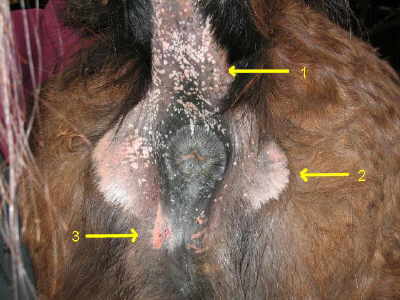Pinworms, Oxyuris equi, in Horses
by Robert N. Oglesby DVM
Introduction
Introduction
»
Clinical Signs
»
The Life Cycle of the Pinworm
»
Diagnostic Information
»
Treatment
»
More Info & Discussions
This unusual parasite of horses, Oxyuris equi, in related to the round worm. Because of its shape it is referred to as the equine pinworm. It is often attributed as a cause of tail scratching in horses. This article contains life cycle, clinical signs, diagnosis, treatment and prevention.
Clinical Signs
Introduction
»
Clinical Signs
»
The Life Cycle of the Pinworm
»
Diagnostic Information
»
Treatment
»
More Info & Discussions
Most often first noted is tail and butt rubbing to the point of hair loss and occasionally excoriation. Some ulceration can result from the feeding of larvae on the perianal mucosa. Most damage is done as a result of the intense itching caused by the sticky fluid used to attach the eggs to the rump.
 Arrow pointing to a pinworm egg mass. The consistency is like sticky mucous.
Arrow pointing to a pinworm egg mass. The consistency is like sticky mucous.
|
 1: Spots of dipigmentation from chronic irritaton of egg masses.
2: Hair loss from irriation and rubbing.
3: Abrasisons from aggressive rubbing.
1: Spots of dipigmentation from chronic irritaton of egg masses.
2: Hair loss from irriation and rubbing.
3: Abrasisons from aggressive rubbing.
|
Rubbing and scratching may cause wounds to open to infection, as well as irritation, and loss of hair commonly known as "rat tail." Severe cases can lead to nervousness and anorexia. Where pinworms are a problem, the cause horses to have a poor appearance and heavily infected horses may also be very irritable. Equine pinworms apparently invoke acquired immunity because the prevalence of patent infections is much lower in mature horses therfore most often it would be expected as a problem in young horses. Adult horses can develop oxyurosis, however, if never previously infected or it may be a problem in older horses with PPID (Equine Cushings) who have impaired immune systems.
In large infections adult pinworms may be observed in freshly passed feces especially for the first few days following a deworming. Rarely adult females may be observed protruding from the anus. Fresh or dried egg masses can be observed on the anus. The fresh material is a greenish yellow and pasty, and the dried masses are gray, yellow, or green.
Prior to the 80's this worm may have been a prevalent cause of but and tail scratching in horses. However more effective dewormers and deworming procedures combined with the sensitivity of this parasite to treatment and the very long prepatent period of 5 months has totally removed this parasite from herds that are regularly dewormed with benzimadazoles, pyrantel, or the avermectins (ivermectin or moxidectin). However acquired immunity to all anthelmintics has led to a resurgence of this infection.
Another common cause of chronic tail scratching is insect bite hypersensitivity. It may be possible to differentiate the two by looking at the characteristic patterns of scratching. Culicoides hypersensitivity are pruritic on the tail head, mane and ventral midline. While pinworm irriation tends to be lower on the tail and under the tail.
The Life Cycle of the Pinworm
Introduction
»
Clinical Signs
»
The Life Cycle of the Pinworm
»
Diagnostic Information
»
Treatment
»
More Info & Discussions
To read more on this topic become a member of
Horseadvice.com! Your membership gets you instant access to this and over 600 equine articles on our site. Other benefits of your membership include participation in our discussion boards and access to our one button PubMed search tool for each topic.
Horseadvice.com educates you to be a more knowledgeable horse owner which leads to healthier horses and save you money, we guarantee it. Come Join Us!
 Arrow pointing to a pinworm egg mass. The consistency is like sticky mucous.
Arrow pointing to a pinworm egg mass. The consistency is like sticky mucous.
 1: Spots of dipigmentation from chronic irritaton of egg masses.
2: Hair loss from irriation and rubbing.
3: Abrasisons from aggressive rubbing.
1: Spots of dipigmentation from chronic irritaton of egg masses.
2: Hair loss from irriation and rubbing.
3: Abrasisons from aggressive rubbing.